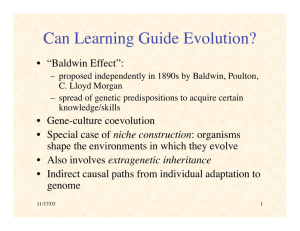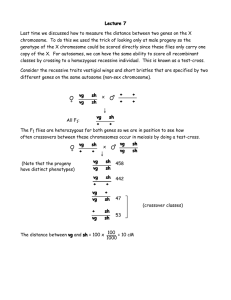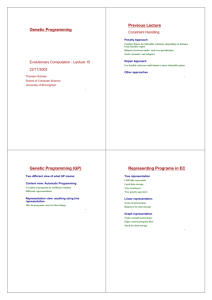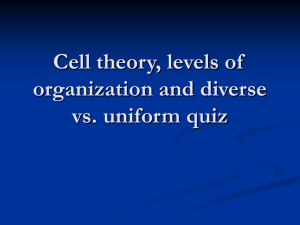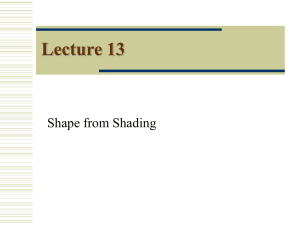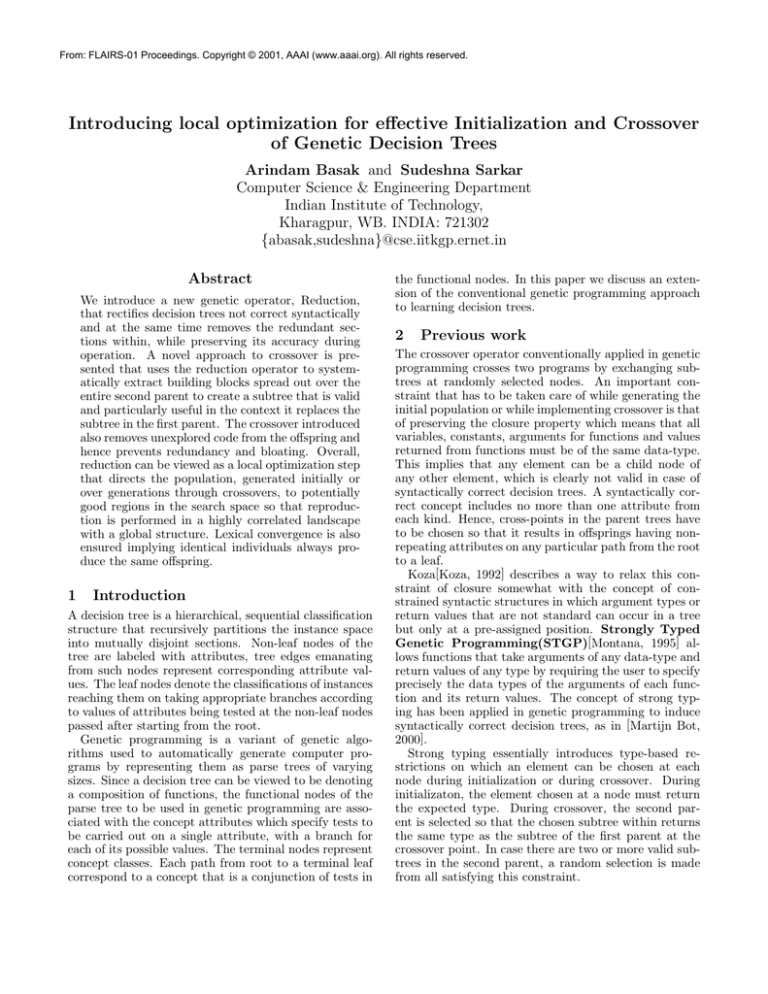
From: FLAIRS-01 Proceedings. Copyright © 2001, AAAI (www.aaai.org). All rights reserved.
Introducing local optimization for effective Initialization and Crossover
of Genetic Decision Trees
Arindam Basak and Sudeshna Sarkar
Computer Science & Engineering Department
Indian Institute of Technology,
Kharagpur, WB. INDIA: 721302
{abasak,sudeshna}@cse.iitkgp.ernet.in
Abstract
We introduce a new genetic operator, Reduction,
that rectifies decision trees not correct syntactically
and at the same time removes the redundant sections within, while preserving its accuracy during
operation. A novel approach to crossover is presented that uses the reduction operator to systematically extract building blocks spread out over the
entire second parent to create a subtree that is valid
and particularly useful in the context it replaces the
subtree in the first parent. The crossover introduced
also removes unexplored code from the offspring and
hence prevents redundancy and bloating. Overall,
reduction can be viewed as a local optimization step
that directs the population, generated initially or
over generations through crossovers, to potentially
good regions in the search space so that reproduction is performed in a highly correlated landscape
with a global structure. Lexical convergence is also
ensured implying identical individuals always produce the same offspring.
1
Introduction
A decision tree is a hierarchical, sequential classification
structure that recursively partitions the instance space
into mutually disjoint sections. Non-leaf nodes of the
tree are labeled with attributes, tree edges emanating
from such nodes represent corresponding attribute values. The leaf nodes denote the classifications of instances
reaching them on taking appropriate branches according
to values of attributes being tested at the non-leaf nodes
passed after starting from the root.
Genetic programming is a variant of genetic algorithms used to automatically generate computer programs by representing them as parse trees of varying
sizes. Since a decision tree can be viewed to be denoting
a composition of functions, the functional nodes of the
parse tree to be used in genetic programming are associated with the concept attributes which specify tests to
be carried out on a single attribute, with a branch for
each of its possible values. The terminal nodes represent
concept classes. Each path from root to a terminal leaf
correspond to a concept that is a conjunction of tests in
the functional nodes. In this paper we discuss an extension of the conventional genetic programming approach
to learning decision trees.
2
Previous work
The crossover operator conventionally applied in genetic
programming crosses two programs by exchanging subtrees at randomly selected nodes. An important constraint that has to be taken care of while generating the
initial population or while implementing crossover is that
of preserving the closure property which means that all
variables, constants, arguments for functions and values
returned from functions must be of the same data-type.
This implies that any element can be a child node of
any other element, which is clearly not valid in case of
syntactically correct decision trees. A syntactically correct concept includes no more than one attribute from
each kind. Hence, cross-points in the parent trees have
to be chosen so that it results in offsprings having nonrepeating attributes on any particular path from the root
to a leaf.
Koza[Koza, 1992] describes a way to relax this constraint of closure somewhat with the concept of constrained syntactic structures in which argument types or
return values that are not standard can occur in a tree
but only at a pre-assigned position. Strongly Typed
Genetic Programming(STGP)[Montana, 1995] allows functions that take arguments of any data-type and
return values of any type by requiring the user to specify
precisely the data types of the arguments of each function and its return values. The concept of strong typing has been applied in genetic programming to induce
syntactically correct decision trees, as in [Martijn Bot,
2000].
Strong typing essentially introduces type-based restrictions on which an element can be chosen at each
node during initialization or during crossover. During
initializaton, the element chosen at a node must return
the expected type. During crossover, the second parent is selected so that the chosen subtree within returns
the same type as the subtree of the first parent at the
crossover point. In case there are two or more valid subtrees in the second parent, a random selection is made
from all satisfying this constraint.
3
Objective
To ensure syntactic correctness of the offspring using
crossover used in STGP, not only one has to search for
a tree which has a subtree valid for the crossover site
in the first parent but also a random choice has to be
made among different valid subtrees if present in the
second parent The main focus is on somehow obtaining
a valid subtree, rather than choosing one which might
increase the accuracy of the offspring. Over generations,
trees produced in this way have large parts which are
never used, and which only contribute to increasing the
tree size without improving its accuracy. Redundancy in
the trees increases over generations, as redundant trees
have a higher chance of surviving crossover. Coupled
with it is the fact that increasing redundancy makes it
less likely to choose a non-redundant edge as a crossover
point and hence hinders the evolution of truly new individuals. Thus, the probability to escape a potential local
optimum decreases with time[Tobias Blickle, 1994].
A new operation of reduction is introduced in this
paper using which a significantly different implementation of crossover is presented which takes care of the
above problems. It has been observed about the random subtree crossover in genetic programming that expressions grow because they are defending themselves
against the destructive effects of crossover and attempting through redundancy to preserve their current fitness
in the next generation[Singleton, ]. The crossover operation introduced here eliminates redundancy. It also
attempts to prevent destructive effects of crossover by
using the building blocks spread throughout the entire
second parent to extract sections which are particularly
useful in the context the generated subtree is going to
appear in the offspring. The method ensures that bloating is prevented and automatically takes care of syntactic correctness of the offspring. This also takes care of
lexical convergence in the sense that two identical individuals produce the same individual as offspring, independent of the choice of the crossover point in the first
parent. In this respect, it is similar to the cut and splice
crossover used in the classical bit string genetic algorithms. The reduction operation introduced can also be
used to remove redundant code from trees generated in
the initial population.
The subroutine implementing reduction takes as input
(i) a decision tree complete with all annotations except
for the labeling of the terminal leaves(labeling of the
leaves, if present, is ignored). and (ii) a set of labeled instances. It produces a syntactically correct decision tree
with terminal leaves labelled appropriately with concept
classes. The recursive algorithm for reduction is outlined
below :
REDUCE ( tree T, non-zero instance set I )
OUTPUT : T reduced with respect to I
THE ALGORITHM :
- IF ( T is leaf ) return T.
- IF ( each instance of I is of same class C )
- make T a leaf representing C.
- FOR ( each child subtree t of T )
- let S be the subset of I branching to t.
- IF ( S is non-empty ) REDUCE ( t, s ).
ELSE
- make t a leaf representing the class
of majority of I’s instances.
- IF ( same child subtree r is
traversed by each instance in I )
- make T equal to r.
- IF ( all explored child subtrees are
leaves representing same class C )
- make T a leaf representing C.
- return T.
B
B1
case 3
A1
A2
B3
case 5
B2
A
C
(2-, 5-, 7+)
( 3+, 6+)
D1
C2
C1
D
case 4
(1+, 4-)
D3
D2
The original decision tree
B3
B
B1
+
(3+, 6+)
C2
C
B2
case 2
C1
case 2
(4-)
(2-, 5-, 7+)
case 2
(1+)
B
B1
+
(3+, 6+)
B3
C
B2
(2-, 5-, 7+)
C2
C1
(4-)
+
(1+)
The reduced decision tree
4
4.1
The introduced operations
Reduction
The operation of reduction applied to a genetic program
representing a decision tree with respect to a set of labeled instances uses the program execution path to remove unexplored sections in the code yielding a shorter
code of the same accuracy on the instance set as in
the original version. It effectively removes the redundant tests which were being carried out by the original
program without changing the relative ordering among
the tests retained.Trees incorrect originally get automatically rectified in the process.
Figure 1: Illustration of the Reduction operation (the
cases correspond to those in the algorithm for reduction; labelled instances reaching the nodes are shown in
parentheses).
The procedure is illustrated in Figure 1 for the dataset
in Table 1.
4.2
The Crossover Operation
The crossover operation generates a single offspring from
two parent programs.
instances
1
2
3
4
5
6
7
A
a2
a1
a1
a2
a2
a1
a1
Attributes
B C
b3 c1
b2 c2
b1 c1
b3 c2
b2 c2
b1 c2
b2 c1
Class
D
d1
d1
d2
d2
d1
d2
d1
+
+
+
+
Table 1: Decision table corresponding to the illustrations
reduction and crossover
Two equivalent views of crossover are presented as follows:
CROSSOVER // first view
INPUT: tree T1, tree T2 //the parent individuals
OUTPUT: tree R // the offspring
THE ALGORITHM :
- select a subtree t in T1.
- transform T1 by replacing t with T2.
- reduce the new T1 with respect to the
training data set to obtain R.
- return R.
CROSSOVER // second view
INPUT: tree T1, tree T2 // parent individuals
OUTPUT: tree R // the offspring
THE ALGORITHM :
- select a subtree t in T1.
- reduce T2 with respect to the subset of
training data which would explore t if T1 is
run on the whole dataset.
- replace t in T1 with reduced T2 to obtain R.
- return R.
The crossover procedure is illustrated in Figure 2.
The intermediate tree generated by the first approach
is likely to be an incorrect one but gets corrected by the
subsequent reduction, so that crossover operation preserves the syntactic correctness of decision trees. The
crossover operation generates an entirely new tree by collecting useful building blocks from throughout the second tree. The redundant sections get eliminated, which
ensures that bloating and redundancy are checked.
The second view of crossover evinces the fact that the
tree replacing the selected subtree in the first parent effectively utilizes the classification power of the second
parent as a whole as far as the subset of training instances to be classified by it is concerned. This makes it
more likely that the offspring would be of better accuracy besides being limited in size. Lexical convergence
is taken care of by the fact that the original tree reduced with respect to the set of instances exploring any
of its subtrees yields the subtree itself. The subtree to
be replaced in the first parent is chosen to avoid wasting crossovers by changing code that is never executed
or disrupting code that is working. To ensure this the
subtree rooted at a node randomly selected is considered
to be eligible for replacement only if it is explored by instances of more than one concept class. Hence, leaves
never visited or visited by instances of the same class
are not considered for replacement.
5
Experiments
Performance is measured by a fitness function which assigns fitness score to each individual. For experiments
described in this paper, fitness is simply the accuracy
of the individual with no inherent steps taken to prevent bloating. Only among individuals of same accuracy, trees with lesser number of nodes are considered
fitter. A rudimentary fitness function as the one above
has been deliberately used to let us more clearly examine
the strength of the introduced operations. Tournament
selection is used as the selection method. It means that
a number of individuals are randomly selected from the
population and the fittest two among them are crossed
over to generate a new offspring which overwrites the
worst individual of the tournament in the next generation if the latter is worse than the one produced.
5.1
Results
Parameter settings
Population size : 250
Tournament size : 7
Terminating condition : standard deviation of training accuracy among the individuals in the population
is down to less than 0.001.
Databases
Source : Machine Learning Repository on the website :
http://www.ics.uci.edu/˜ mlearn/MLRepository.html
Title : The Monk’s Problems
Attributes : discrete, 7 in number(including the class
attribute and excluding the instance Id).
Number of classes : 2
3 datasets were used :
monks-1.train(124 instances),
monks-2.train(169 instances),
monks-3.train(122 instances).
Observations and Analysis
Experiments were conducted on learning decision trees
from training data using the proposed approach and the
results were compared with those obtained using the
C4.5 algorithm(Quinlan,1993), an extension of the original ID3 algorithm(Quinlan,1979), a classical approach
for building decision trees from discrete training instances.
For C4.5 the source code was obtained from website :
http://www.cse.unsw.edu.au/˜ quinlan
and the learning was based on training data with subsequent pruning.
The observations were recorded as in Table 2.
In Table 2, corresponding to the tree produced by C4.5
for a given dataset, GP results enlist the individuals,
among those produced during 10 runs of the proposed
algorithm, which dominate the tree C4.5 generates(A
tree is considered to dominate another if the former has
B
B1
(3+, 6+)
B3
C
B2
+
crossover
C
C1
C2
(2-, 5-)
(7+)
+
-
point
+
(2-, 5-, 7+)
_
B2
-
B3
B
B1
+
C1
-
C2
(4-)
(1+)
tree T2
tree T1
replace the chosen
subtree in T1 with
T2 to obtain t1
C1
(7+)
reduce T2 with respect to
examples 2, 5, 7 (which visit
the chosen subtree of T1 )
to obtain t2
C
C2
+
(2-, 5-)
tree t2
B1
B
B3
C
A
B2
C2
C1
C1
C
C2
(i)
B
(ii)
B3
B1
B2
replace the chosen subtree
in T1 with t2 ( reduced from T2 )
tree t1
( intermediate, incorrect
individual )
B
B3
C
C2
B1
B2
+
-
C1
C
+
reduce with respect
to the complete set
(3+, 6+)
C1
C2
(1+)
+
(7+)
(2-, 5-)
The offspring ( syntactically correct
and same for both the approaches
to crossover )
Figure 2: Illustration of the two views of crossover in (i) and (ii)(T1 and T2 are the trees being crossed over to obtain
a single offspring).
Dataset
Algoritm
C4.5(unprunned)
GP
monks-1
C4.5(prunned)
GP
C4.5(unprunned)
GP
C4.5(prunned)
monks-2
GP
monks-3
C4.5(unprunned)
GP
C4.5(prunned)
GP
Training
Accuracy
90.32
100.00
99.19
98.38
97.58
96.77
95.96
95.16
94.35
93.54
92.74
91.93
91.12
90.32
83.87
87.90
87.09
86.29
85.48
84.67
83.87
85.79
85.79
76.33
78.69
78.10
77.51
76.92
76.33
96.72
96.72
93.44
93.44
Number of
Nodes
43
37
35
33
31
29
29
27
25
25
23
23
21
19
18
18
17
17
14
16
14
73
61
31
28
29
26
24
23
25
25
12
12
Table 2: Genetic decision trees compared with those
learned using C4.5.
at least as much accuracy and at most as many number
of nodes as compared to the latter). C4.5 trees both
before and after prunning are compared.
As is evident from the observations, the genetic decision trees produced are in general of much smaller size
compared to those of similar accuracy learned by C4.5,
wheather before or after prunning.
This shows that the heuristic based deterministic
search done by C4.5 was unable to generate optimal trees
and the genetic trees produced were better in comparison. Experiments are yet to be conducted comparing
the proposed approach with the state of the art ones in
genetic programming and it is likely that the former will
generate better individuals in shorter time.
6
Conclusion
Reduction has been introduced as a local improvement operator used during initial population choice and
crossover to guide candidates which are unfit or which
violate problem constraints to nearby locally optimal regions in the search space. The context-preserving nonuniform crossover proposed in this paper collects useful sections from the parents while rejecting the redundant ones so that the generated offspring is syntactically
correct, limited in size and likely to be of higher accuracy. Prolification of building blocks and lexical convergence are also taken care of. In this way, exploration
of search space is limited to reasonably good points so
that global or nearly-global solutions are obtained reliably and quickly.
References
[Koza, 1992] Koza, J. R. 1992. Genetic Programming:
On Programming Computers by Means of Natural Selection and Genetics. The MIT Press, Cambridge,
MA.
[Martijn Bot, 2000] Martijn Bot, W. 2000. Application
of genetic programming to induction of linear classification trees. In European Conference on Genetic Programming EuroGP2000, Lecture Notes in Computer
Science 1802, 247–258. Springer.
[Montana, 1995] Montana, D. J. 1995. Strongly typed
genetic programming.
Evolutionary Computation
3(2):199–230.
[Singleton, ] Singleton, A. Greediness. Posting of 8-211993 on genetic-programming@cs.stanford.edu mailing list.
[Tobias Blickle, 1994] Tobias Blickle, L. T. 1994. Genetic Programming and Redundancy.


